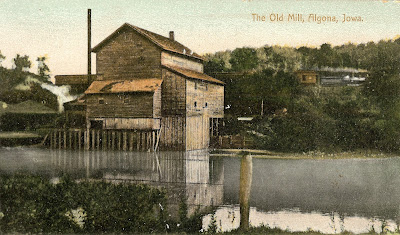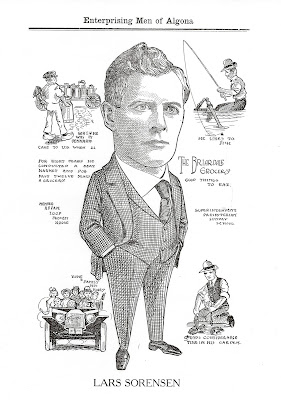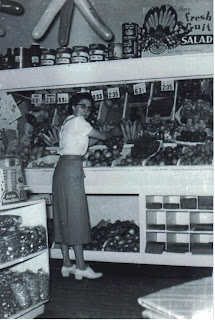One
of my past posts told the story of the drowning of the young wife and two small
children of Professor F.M. Shippey near the old mill. Following that post I had several comments or
questions concerning the mill itself and so I decided to delve into the history
of the business. I grew up in the neighborhood where the mill was located and
remember hiking in the area near the river as a child.
THE
ERECTION OF THE MILL
In
1865 at the time the Civil War was still raging, a Mr. M. M. Foster began the
construction not only of a saw mill but also the creation of a dam. The mill was nestled on the south side of the
bend of the river just west of the bridge across Old Mill Drive (which later
became known as Highway 169) and north of today’s Veterans Park Drive. In its early days, John Heckart, father of
Sarah Call, operated a turning lathe there which he used to manufacture many
pieces of furniture and other specialty items.
 |
| Note wooden bridge over river |
The
original dam was constructed of brush and dirt by Mr. Foster which many locals
believed to be unwise. They were proven
right when an enterprising muskrat burrowed his way through the dam. Within an hour the rushing torrents swept
away the dam and rolled the mill into the river. Thankfully, J. E. Stacy came to the rescue,
purchasing a half interest in the property.
With the help of the community a more substantial dam was installed. The building itself was enlarged and a stone
for grinding flour was added.
 |
| Jerome E. Stacy |
Stacy
bought out Foster’s interest in 1868 and eliminated the saw mill entirely. D. W. King later purchased a half interest in
the mill and actually ran it for many years.
In 1881 J.B. Jones purchased King’s interest and remained as co-owner
under the firm name “Stacy & Jones.”
These partners would go on to operate the mill for 16 years.
 |
| 1896 plat map showing mill and all three dams |
During
Jones tenure, two additional dams were installed to head off the river from
cutting a new channel across the flat. The
old dam by the mill was also rebuilt on several occasions. All of this came at a great cost to the
owners. It was estimated that over the
years $5000 was spent in construction and maintenance of the dams alone. They also enlarged the building, installed a
boiler, an engine and improved machinery.
The
building was about 40x60 feet on the ground and 30 feet high. The engine house was 18x30 feet. The old portion of the building was framed in
oak.
In
1897 Jones sold his interest to J.E. Stacy, making him once again the sole
owner. The following year Stacy sold a
majority interest to Farmers’ Milling Company for $8,000. The company had 125 shareholders with a board
of directors consisting of C. Rickard, Myron Schenck, J.W. Wadsworth, C. Byson,
H.W. Dryer, C.E. Heise, J.E. Stacy, James Nolan, and Sam Steussy.
A
PHOTOGRAPHER’S DREAM
The
mill became a favorite for photographers of all skill levels. It had been constructed on a scenic bend in
the Des Moines river and the dam had created a mill pond nearby which was a
popular spot for fishing, boating and swimming in the summer and ice skating in
the winter. The river in the area and
the island to the north of the mill were lined with trees and shrubbery giving
them a park-like appearance—just perfect for picture taking. Postcards of children fishing along the banks
of the river show the old mill as a backdrop and photos of the landmark graced
calendars and other area advertising.
 |
| Metal bridge provided good view of dam |
The
bridge to the east of the mill was a favorite spot for spectators to view the
dam, the mill and other activities in the area.
Visitors would sometimes spend several relaxing hours leaning on the
side of the bridge watching the water tumble over the dam.
Unfortunately,
the dam was also the site of several tragedies through the years. In addition to the drowning of Mrs. Shippey
and her children, Claude and Delta, a young Civil War veteran, O.A. Atwood,
lost his life while swimming there on a hot summer afternoon.
A
PIONEER RELIC GONE
While
getting ready to turn in for the night around 10:30 p.m. on Friday, January 31,
1902, C.E. Heise happened to look out the north windows of his home located on
the hill just to the south and noticed flames at the mill. In a short time, many neighbors from the area
rushed to the site. Had buckets been
available, it was theorized that the main part of the mill might have been
saved. However, by the time the fire
department responded the flames were so hot the firemen could not get close
enough to attempt to extinguish the fire.
The fact that the mill was situated beyond the water system of the city
also limited the response. Although not
mentioned in the news articles of the time, the normal temperatures of a
January night would surely have hampered any firefighting efforts.
The
mill was soon engulfed with flames shooting up fifty feet high with the burning
timbers giving off a white heat. The
main part of the building collapsed about 11:30 p.m. The intensity of the fire was
sufficient to warp the new steel bridge over Old Mill Road slightly, but did not
cause any serious damage.
So
how did the fire start? Its origin was
never officially pinpointed. The mill
had been closed that Friday for machinery repair. When employees left that evening, there was
no fire anywhere about the building nor had there been all day. The blaze itself began on the north end of
the engine room, away from the coal supply.
There
were several theories. J.E. Stacy
believed that someone fishing started a fire to keep warm and then did not
fully extinguish the blaze before leaving.
The mill was banked with manure which could easily have ignited when an
unattended fire spread to its location.
A
gentleman by the name of George Hollins claimed that when he was on his way
home about 8 o’clock that evening he saw what appeared to be a lantern moving
in the second story. Had someone broken
into the mill and started the fire?
Others
thought the slack coal in the engine house spontaneously combusted causing the
inferno.
Whatever
the cause of the fire, it was soon discovered that the insurance policy covering
the facility had expired just a few days before the event. The milling company was incorporated which
protected the private property of the stockholders with the exception of
several board members who had guaranteed promissory notes.
 |
| Photo from 1913 History of Kossuth County showing road |
PROTECTING
THE DAM FOR THE TOWN
The
community of Algona mourned the loss of this pioneer relic. It wasn’t long, however, before citizens
began to express their concern that the dam must be protected, especially if judgment
creditors forced the property to be sold.
The high stage of water provided by the dam afforded a source of ice for
Algona’s ice houses. These businesses
provided ice to creameries year round for a dozen miles in all directions.
The
City of Algona finally was able to purchase the dam for $250 in the spring of
1906 with plans of installing a dynamo to produce electricity, but also to
provide a sufficient flow of water to clear sewage from the river so that ice
could be provided to creameries and for other necessary uses. I could not find any evidence that the dynamo
project ever came to fruition.
TODAY
Today
the bridge over the highway has been moved farther to the east and the “old
mill road” has been redirected. The
channel of the river which cut to the north where dams were strategically
installed to keep as much water flowing to the mill site as possible has been
re-routed so that there is now only one channel that twists and turns through
the north end of town.
 |
| Looking toward the site from the bridge over Highway 169 |
It
was said that J. E. Stacy would have died $50,000 richer if he had never seen
the mill. Despite every effort to make the company successful, the old mill and
the dams that served it were a poor business investment, due much to the
fluctuating river levels. Our early
pioneers went to great lengths to bring innovation and progress to their new
home, despite much personal financial and physical risk. It is good that the memories of structures
like the old mill linger on reminding us of their sacrifice.
Until
next time,
Kossuth
County History Buff
If you enjoyed this
post, please don’t forget to “like” and SHARE to Facebook. Not a Facebook
user? Sign up with your email address in the box on the right to have
each post sent directly to you.
Be sure to visit the
KCHB Facebook page for more interesting info about the history of Kossuth
County, Iowa.
Reminder: The posts on Kossuth County History Buff are ©2015-17 by
Jean Kramer. Please use the FB “share” feature instead of
cutting/pasting.







